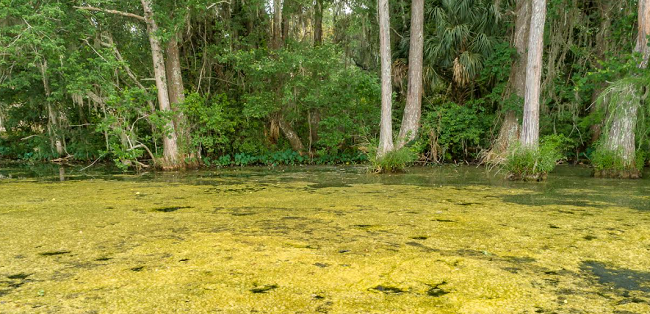The Leon County Board of County Commissioners heard an update on the algae bloom occurring in Lake Munson during the July 12, 2022, county meeting.
In May 2022, the county closed the boat ramp and warned the community of toxins in the lake. Tallahassee Reports previously covered the story.
According to the report presented to elected officials during the meeting, Lake Munson continues to improve, though slowly. The dominant algae in Lake Munson are currently filamentous algae on the lake’s surface, mostly attached to the tops of the aquatic vegetation that has grown to the surface.
The algae produce low-level microcystin toxins, Microcystis Aeruginosa, a type of microalgae that floats in the water column. These toxins triggered the health alert and prompted discussion about the lake’s water quality.
The health alert will remain until the toxins are no longer detected and there is no longer an active algae bloom.
The report showed that the most recent water sample collected by the Florida Department of Environmental Protection (FDEP) on June 14 still showed low levels of the microcystin toxins.
Also, the update notified the county of the $12.1 million state grant and local matching dollars that the county will invest to design, permit, and construct a central sewer system for neighborhoods on the northeast side of Lake Munson. Many residences surrounding Lake Munson do not have sewer connections and require septic tanks. The project will allow approximately 220 property owners to connect to a central sewer at no cost to the homeowners. Construction is anticipated to begin in the fall of this year.
Ongoing efforts to improve the water quality and reduce the nutrient loading in Lake Munson have occurred since the 1990s by the county and city. The local governments have dedicated millions of dollars and completed numerous projects upstream of Lake Munson to provide water quality treatment, reduce sediment transport, and collect trash.
According to the report, the efforts have proved effective. Results of water quality testing by the county and city have indicated that the quality of water entering the lake is better than the water in the lake itself.
During public comment, Mike Elfenbein, the Conservation Chair of the Cypress Chapter of the Izaak Walton League, recommended that the Board consider measures that Charlotte County takes to mitigate algae blooms in Lake Okeechobee.
Elfenbein spoke of a $3 million DEP federal grant the county can apply for that will assist in their efforts to clean up Lake Munson.
The program Elfinbein spoke of harvests invasive aquatic plants from Lake Okeechobee. Those plant materials are then liquified and used for nutrients on land for agriculture.
Commissioner Nick Maddox motioned for the county to apply for the $3 million federal grant suggested by Elfenbein and then to have a status update during the next county meeting in September. The motion passed unanimously.


A skeptic —
Actually, the muck on the bottom of Munson has NEVER been cleaned up. In the early 2000s, the delta area of Munson Slough was exposed and dredged, but it was a very limited area overall.
There has NEVER been a cleanup of the organic muck deposited there over the last 100 years, despite being the #1 recommendation going back to at least 1994’s Lake Munson Management report.
Without getting rid of these legacy nutrients at the bottom, the lake cannot ever recover, even if the inflows improve.
The reality is that simple septic systems are excellent at removing harmful pathogenic bacteria (like E. coli) from sewage and waste water as it works its way back into the water table. However, septic systems are not effective at removing nutrients (like nitrates and phosphorous) that feed other bacteria and algae and result in these ‘blooms’ in lakes and rivers. Obviously, a failing septic system can also spill harmful pathogenic bacteria into the groundwater.
I don’t begrudge the county for trying to fix the problem. They’ve been grappling with a polluted Lake Munson for as long as I can remember. This is not a new problem.
Out of control development results in pollution. Now we need money to fix it, cry the developer owned politicians.
It wasn’t that long ago that the lake bottom was exposed and cleaned up.
What, exactly, is “feet of organic muck legacy nutrients on the bottom of the lake” and how did it get there in such a short period of time?
Actually, it’s me who is writing the grant for the State’s Innovative Technology and suggested the BOCC apply with input from the Terry Ryan and the Tallahassee Swage & Wakulla Basin Advocacy Group along with Leon County staff. It might be one of the most consequential environmental votes the board has taken in decades.
This grant will provide for long-term planning for the entire watershed, including retrofitting current ponds with updated computer models and current technology and testing for nutrient pollution and toxins upstream to keep it from reaching the lake in the first place.
The grant will cover the remediation of the lake by mechanically harvesting the toxic algae, invasive plants, and feet of organic muck legacy nutrients on the bottom of the lake that feed the blooms, providing more immediate relief for sick homeowners and pets in the area.
At that point, Blueprint will be brought in for another round of grants next year when they construct the final Capital Cascades 4 stormwater facility, with the suggestion it be placed on the west side of the lake to act as a “kidney” system to keep the lake clean going forward, as well as planting native vegitation.
Equally important, the BOCC voted to make lowering Munson’s TMDL from 0.75 mg/L nitrogen to 0.35 mg/L a priority, a huge accomplishment for the health of the lake and Wakulla Springs. This grant will examine how to make that happen and implement it.
All at no cost to the county.
Gosh, what a mess. Leon County elected imbeciles. What did you think would happen?